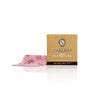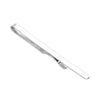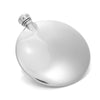![]()
A money clip is the most refined way to carry notes and a few essential cards. It is a small engineered piece that grips currency securely and keeps your pocket flat. Where a wallet adds bulk, a money clip removes it. The result is a cleaner silhouette, quicker access, and an accessory that reads as intentional rather than incidental.
What Are Money Clips?
At its simplest, a money clip is a sprung or hinged piece of metal that holds folded banknotes and, in many designs, one or two cards. Traditional British styles favour solid precious metals that take a high polish and age with character. Good clips apply even pressure along the stack so the contents do not creep. They feel purposeful in hand and disappear quietly in a jacket or trouser pocket.
A money clip is minimal on purpose. It carries exactly what you need and nothing that you do not.
Typical constructions include solid precious metal with a spring temper, or a two-part mechanism where a flexible backplate provides tension against a polished face. The best examples avoid sharp edges, keep a low profile, and retain tension after years of daily use.
Cash Is King: Do People Still Use Money Clips?
Yes, and for good reasons. Cards handle everyday transactions, but there are moments when notes are practical and polite. Tips, taxis, coat checks, club entries, market stalls, and small gestures at events all favour cash. A money clip makes those moments smooth. It is faster than a wallet and neater than loose notes. For travel and evening wear it is ideal, keeping your pocket streamlined and your essentials organised.
Formal dress rewards restraint. A slim clip keeps the line of a dinner jacket clean where a bulky wallet would distort it.
Beyond practicality, a money clip signals taste. It is a quieter expression than a branded wallet and it pairs naturally with other traditional accessories like cufflinks, a tie slide, or shirt studs.
Buying a Money Clip as a Gift
A money clip makes a precise and memorable gift. It suits promotions, retirements, milestone birthdays, groomsmen, and thank yous that deserve to feel permanent. Choose a material that complements the recipient’s usual watch, cufflinks and accessories, consider engraving for meaning, and keep the design clean so the piece remains versatile for decades.
Silver vs. Gold
Sterling silver is the most versatile choice. It reads professional in daylight, elegant in the evening, and pairs naturally with navy and grey tailoring. It develops a gentle patina with use that can be polished back to brightness when desired.
9ct yellow gold brings warmth and ceremony. It suits celebrations, evening wear, and wardrobes built around brown, olive, or cream tones. Gold also presents engraving with soft contrast that feels quietly luxurious.
| Metal | Best pairing | Occasions | Why choose it |
|---|---|---|---|
| Sterling silver
|
Navy and charcoal tailoring, silver-tone watch
|
Business, travel, black tie | Crisp, versatile, and easy to coordinate across wardrobes |
| 9ct yellow gold
|
Brown, olive, camel, cream, gold-tone watch
|
Weddings, retirements, evening events | Warm tone, heirloom feel, engraving shows beautifully |
| 9ct rose gold
|
Stone, taupe, mid-blue, soft pink, mixed-metal wardrobes
|
Daytime formal, contemporary business | Bridges cool and warm palettes while remaining understated |
Match the clip to the watch. When your metals agree, the rest of the outfit falls into line.
Engraving
Engraving is where a money clip becomes personal. Keep it brief and well placed. Initials, a date, or a short inscription are enough. For discretion, place the engraving on the inner surface so the message is discovered rather than displayed. For ceremony, a small monogram on the outer face can be appropriate on heavier pieces.
Fonts: Classic serif and clean block scripts age best. Avoid overly decorative faces that may date. Layout: Centre the engraving and keep margins generous. The negative space is part of the design. Depth and finish: A crisp cut with a polished or matte infill reads clearly without shouting.
The right inscription is short, specific, and timeless. It should make sense to the wearer many years from now.
Presented in a lined box, with a note explaining the engraving, a well-chosen money clip feels complete. It is useful immediately and meaningful for the long term, which is exactly what a proper gift should be.
History of the Money Clip
The idea behind the money clip is older than currency itself. Early versions were used in ancient Mesopotamia and in Japan during the Yayoi period to fasten storage notes for grain and rice. Once paper money arrived in Europe in the 13th century, people used clips to secure banknotes to their clothing as protection against pickpockets. The modern form emerged in the early 1900s, when precious metal clips became a mark of refinement among wealthy businessmen in the United States. Designs were eventually patented, refined, and miniaturised into the familiar sprung form used today. After the Great Depression, open displays of wealth fell out of favour and traditional wallets took over, but money clips never disappeared. They remained the choice of men who preferred a slim pocket, a clean line, and the quiet luxury of a well-made object.
The perfect pairing to a money clip for the classy gent in your life? A set of cufflinks. Read our Ultimate Guide to Cufflinks to find out more.







